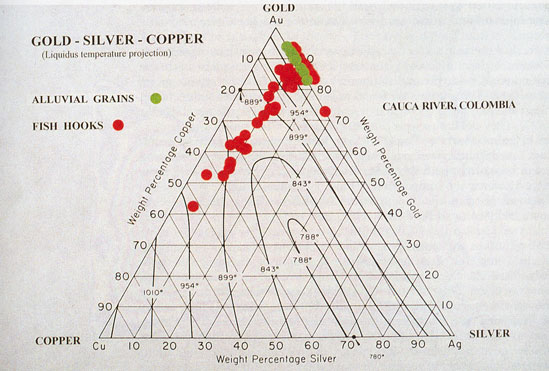Gold and Copper Alloys dissolve in one another in all proportions, forming a complete series of homogeneous alloys, which are less malleable, harder, more elastic, and more fusible than gold, and possess a reddish tint. Those with less than 12 per cent, of copper are fairly malleable; when more than this is present they are more difficult to work owing to their hardness. Since no change of volume occurs when these alloys are formed, their densities may be calculated from those of gold and copper. The density of standard gold is 17.48, and that of the alloy containing gold 900, copper 100 is 17.16. For the densities of other gold-copper alloys. Many of the alloys have been used for coinage at various times. The Greeks and Romans, after electrum had fallen into disuse, employed the purest gold they could procure, viz., that from 990 to 997 fine. Under the Roman Emperors, however, copper was intentionally added, and in the two centuries preceding the fall of Rome very base alloys were used, some containing only 2 per cent, of gold, or even less. In the middle ages these base alloys were discarded, and the “ byzant ” of Constantinople and the “ florin ” of Florence were both nearly pure gold, while the first gold coins struck by the nations of Western Europe were also intended to be absolutely fine. The standard 916.6 or 11/12 (i.e., 916.6 parts gold in 1,000) was adopted by England in the year 1526, the standard of 994.8, which had been introduced in 1343, being finally abandoned in 1637; the 900 standard was introduced in France, and subsequently adopted in other countries. These two standards are now those most commonly used, the English standard being employed by Russia, Portugal, India, and Turkey, and the French standard by most other civilised countries; the Austrian ducat, however, has a fineness of 986 and that of Holland a fineness of 983, while the Egyptian standard is only 875. Of all these alloys the 900 and 916.6 standards are those best adapted for coinage, keeping their colour fairly well, and resisting wear better than richer alloys. The 900-alloy is harder and wears better than the 916.6-alloy, but the difference is not great, the rate of wear depending less on such small differences of composition than on the mechanical and thermal treatment of the alloys during the operation of coining. The alloys used in coinage generally contain from eight to twelve parts of silver per 1000 in addition to the gold.
Gold-copper alloys tarnish on exposure to air owing to oxidation of the copper, and blacken on heating in air from the same cause. This oxidised coating may be removed and the colour of fine gold (not that of the original alloy) produced by plunging the metal into dilute acids or alkaline solutions, the operation being technically known as “ blanching.” The colour of alloys may be improved without previous oxidation by dissolving out some copper by acids, a film of pure gold being thus left on the outside which can be burnished. French jewellers use a hot solution of two parts of nitrate of potash, one part of alum, and one of common salt for this purpose.
Nitric or sulphuric acid dissolves out the copper from gold- copper alloys under conditions similar to those under which it removes silver from silver-gold alloys. If the copper falls below 6.5 per cent, the alloy is not attacked by these acids (Pearce). Aqua regia dissolves all the alloys completely.
https://www.youtube.com/watch?v=ysSTYUHcEJg
